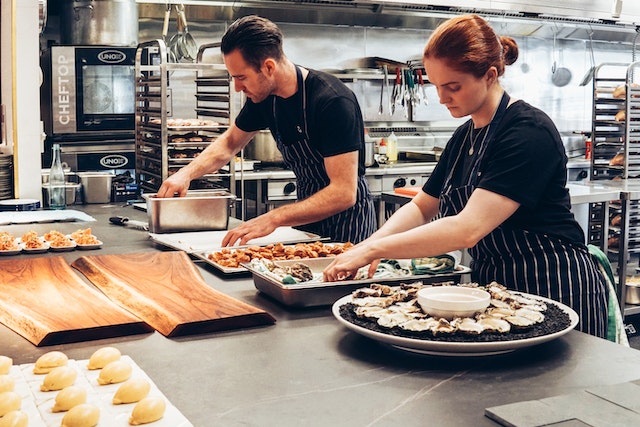Restaurant operators are seeking to incorporate more efficiencies into their operations as they face rising costs for labor, utilities and other expenses.
A recent survey from the National Restaurant Association found that 89 percent of operators said labor costs remain a significant challenge, and 62 percent don’t have enough employees to support existing demand. And, according to the NRA’s 2023 State of the Industry Report, only one in 10 operators think recruiting and retaining employees will be easier in 2023 than it was in 2022.
While more than half of operators—58 percent—said they think using technology and automation to alleviate labor shortages will become more common in their segment in 2023, many are instead looking for other ways to streamline their operations and reduce costs, including rethinking their operations to incorporate more prepared and partially prepared ingredients.
Big Chicken, for example, the chicken sandwich chain backed by National Basketball Association veteran Shaquille O’Neal, has built its operations around eliminating prep labor by developing custom recipes for its sauces, breading, and other ingredients, and then outsourcing their production to meet its specifications.
“We try to remove labor from the restaurants by bringing in as much of the ingredient prep already pre-done as we can,” said Josh Halpern, CEO, Big Chicken. “Our spices are pre-mixed, our sauces are pre-made, our cheese sauce [for the macaroni and cheese] is pre-done, et cetera, which reduces the amount of ingredient prep time in the restaurant.”
The company worked with its culinary team to create recipes that could be produced in bulk and supplied by manufacturers. While the actual breading and frying of the chicken is done to order in the restaurant’s kitchens, the cooks and sandwich-assembly workers at each of the chain’s two dozen locations are using ingredients that have been pre-made, he said.
Even the ice cream mix used in the chain’s milk shakes was custom developed for Big Chicken, Halpern said. The company works with California-based Scott Brothers Dairy, a 110-year-old dairy farm known for its sustainable practices and high-quality products.
“Our chefs sat with the dairy for a couple of days and figured out what the ice cream mix should be,” said Halpern. “We’re not just going to a broadline distributor and saying, ‘OK, I’ll take this product and that product.’ We are very much about finding the right food profile for our consumer—how do we elevate that chicken, fry and shake experience?”
Other products that are custom-made for Big Chicken include its ice cream sandwiches and its Big Cookie, a massive, shareable treat described as a “Shaq-sized” chocolate chip cookie.
In some cases, the chain was able to find an off-the-shelf product that met its specifications, such as the buns it sources from Turano Baking Co., a European-style bakery with operations in several locations around the country.
“We found a bun that we felt was of the utmost quality and artisanship that really spoke to who Big Chicken was,” said Halpern.
Restaurants of all kinds, including high-end, fine dining establishments, have also shown an increased interest in partially prepared produce items from Baldor Specialty Food, said Scott T. King, vice president of sales at the New York-based distributor.
“We’ve definitely seen an increased demand for Fresh Cuts, which is our line of premium cleaned and prepped produce,” he said.
Sales of the line have grown 4 percent year over year, and 7 percent for the top 20 items, said King.
In addition, Baldor has seen a growth of 5 percent across its line of Urban Roots homestyle fresh salsas, he said. The line is available in both retail—in Whole Foods and other retailers—and in foodservice.
“Besides the salsa, we’ve seen sales growth in some standard processed veg options like butternut squash chunks, cauliflower florets, diced leeks, organic ginger, and peeled parsnips,” said King. “Additionally, we’re seeing high sales velocity on some newer items including squash noodles, zucchini noodles, and our vegetable kabob kit.”
He sees the demand for fresh-cut produce across the spectrum of restaurant types, from fast-casual to fine dining, and across the range of fruit and vegetable types.
“What makes our offering special is the fact that it starts with the highest quality ingredients, which makes it more acceptable to those chefs on the higher tiers of fine dining whom you wouldn’t necessarily think would use a prepped product,” said King.
He said he expects the trend toward restaurant demands for partially prepared foods to accelerate.
“Labor shortages are affecting the entire industry, and everyone is looking for ways to deliver to their customers despite the difficulties finding talent,” said King. “In addition, the cost of kitchen labor will only go up.”
Part of the value proposition of Fresh Cuts is that the products can offset some labor costs for Baldor’s restaurant customers, he said. The ongoing labor crunch, combined with increasing demand for plant-based options, will continue to fuel demand, he predicted.
“Restaurants will find themselves more in need than ever of produce that they don’t have time or resources to prep,” he said.
In addition to minimizing labor costs in the kitchen, prepped produce also reduces the safety risks of knife injuries, optimizes storage space, and provides a convenience factor that is critical in fast-paced kitchens, said King.
Related: A Fancy New York Pitch Slam at the Summer Fancy Food Show; SFA Webinar: Selling to Convenience Stores.

